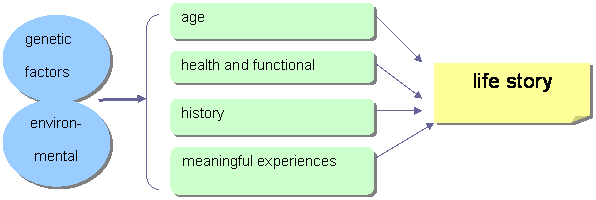
LIFE STORY
The life story of the elderly
The acquaintance of the life story of the elderly helps the carer to understand profoundly the current situation of the functional capacity. This acquaintance makes it possible for the carer to recognise the resources and problems in the functional capacity. When the carer knows the important and enjoyable things of the elderly, the carer can use them in present situations. For example music, which has been enjoyable as young, can be enjoyable in the old age.
The present functional capacity is bound to the life history of the elderly. The life of every elderly can be defined as a story. Every life consists of many small stories which start from birth and end to death. The life story of each elderly tells and teaches something important from the elderly’s life. The carer can collect the life story using for example the model of the life span. The carer can document the life story literally or as a mind map.
Pictuce. The wholeness of the life story of older people
Historical factors mean to the same generation common experiences. These are e.g. war time, economical depression or boom, the development of health care, education, the changes in the structures of economical life and family.
Meaningful experiences are personal and unpredictable experiences which stay in the memory. These are e.g. the changes the one’s health and wellbeing, the changes in the lives of the family members, losses of relatives or friends, the changes in one’s jobs and living environments.
In the life story the life of the elderly is a process, which is made comprehensible both to the elderly and his / her relatives and the carers. The elderly is active in telling his / her own life story to the carer, who documents the facts. Also the relatives, close friends and care documents can be sources of information. These secondary sources are the more important the less the elderly can act as an active story teller. The collecting of the life story is also a process that deepens and widens by the time.
The elderly’s experiences and happenings in childhood, youth, adulthood, third age and old age are documented in the life story. The development and growing happens through life span. Each life is a personal wholeness and in each phase there are different roles and duties. Each person fulfils his / her own personality and is his / her own life’s active actor who affects to his / her own life’s directions. On the other hand each person is always bound to the historical and cultural changes.
The life story of the elderly is always an individual, authentic description of her / his life and its nature varies according to its context. The elderly tells her / his own story, which is genuine and true. The carer documents the stories and experiences without interpretation.
The elderly gives to the happenings and episodes of his / her life different meanings. The plot of the story is the life itself. The story can be happy or unhappy, glad or sad. All stories are meaningful despite of the length or the content of the story. The life of every elderly has been imprinted by the past and it has given also contents and provisions for the future. Life story is an experiential process in which the elderly as a subjective actor gives own meanings to it. The personality influences how the elderly experiences the happenings.All older people can not tell their own story to the carer. The family and relatives can in those cases give the information. They can tell how the life has been from the childhood till today. They can either tell or write about the life of the elderly. The carer can help them by giving themes around which the story is built
The carer is able to find out the life story of the elderly creatively and profoundly if she / he has a holistic view of the functional capacity thinking. The carer can use the areas of functional capacity as themes and concrete happenings concerning them. The result as a life story can be creative and personal which includes e.g. photos, poems, idioms and aphorisms.
